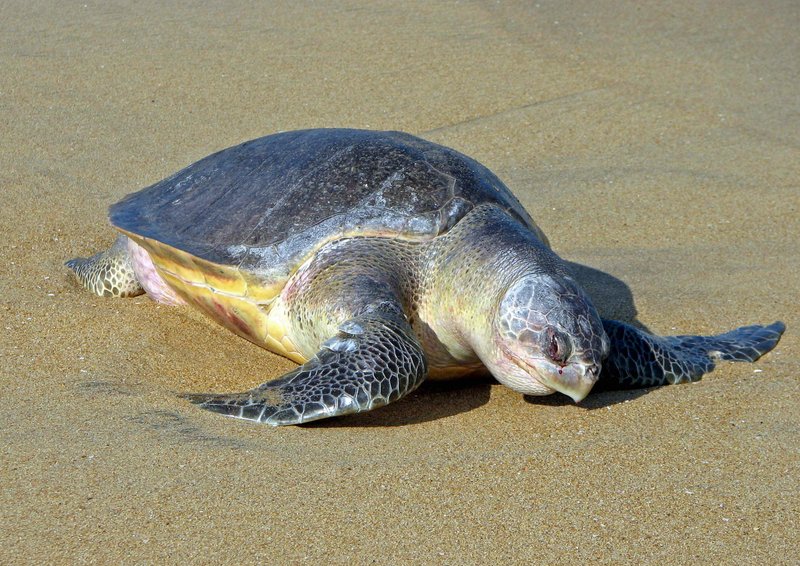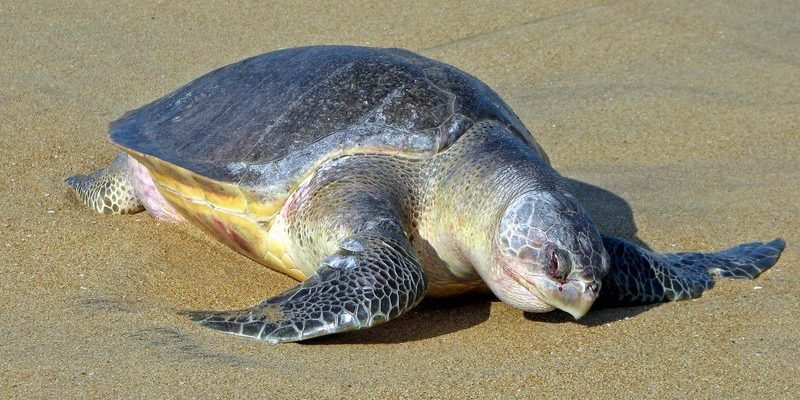
Imagine a creature that glides through the warm waters of the ocean, its shell shimmering under the sunlight. The Olive Ridley Sea Turtle is one such remarkable animal. Known for its gentle nature and fascinating life cycle, this turtle captures the hearts of many. It’s not just its looks that are captivating; it’s also its intriguing behaviors and the challenges it faces in the wild.
These turtles are part of the Cheloniidae family and are among the smallest sea turtles in the world. The Olive Ridley’s unique name comes from the olive green color of its shell, which often appears more grayish in certain lights. If you’re curious about where they live, what they eat, and the threats they face, you’re in the right place. Let’s dive deep into the fascinating world of the Olive Ridley Sea Turtle!
Physical Characteristics
The Olive Ridley Sea Turtle might be small compared to other sea turtles, but it has some impressive features. They typically weigh between 75 to 100 pounds and measure about 2 to 2.5 feet in length. Their rounded shells are relatively flat, which aids in swimming and maneuverability. The shell is often a soothing olive color, leading to their name, but variations in color can occur.
Another notable characteristic is their heart-shaped shell, which sets them apart from many other turtle species. This shape not only contributes to their hydrodynamic ability but also impacts their reproduction. Female Olive Ridleys typically nest in a synchronized mass nesting event known as “arribada,” where thousands of females come ashore to lay eggs at the same time. This overwhelming number helps to protect their eggs from predators, as not all can be consumed at once.
Habitat and Distribution
The Olive Ridley Sea Turtle is found in tropical and subtropical oceans around the world. They prefer warm waters, which is why they often inhabit areas like the eastern Pacific and the Indian Ocean. These turtles can be seen along coastlines and sometimes venture into deeper waters, especially during their migration periods to feeding grounds.
When nesting, Olive Ridleys tend to opt for sandy beaches. This is vital for their reproduction, as they require a safe environment to lay their eggs. Some of the most significant nesting sites include the coasts of Costa Rica, Mexico, and India. Due to their migratory habits, it’s not uncommon to find them traveling long distances between feeding and nesting areas.
| Characteristic | Details |
| Weight | 75 to 100 pounds |
| Size | 2 to 2.5 feet in length |
| Color | Olive green to grayish |
| Habitat | Tropical and subtropical oceans |
| Nesting | Sandy beaches |
Diet and Feeding Habits
While their diet seems simple, it plays an essential role in maintaining the health of marine ecosystems. By feeding on jellyfish, they help control the population of these creatures, which can sometimes bloom excessively and disrupt the balance of marine life. This interconnectedness highlights how essential Olive Ridley Sea Turtles are in their environments.
Reproduction and Life Cycle
The life cycle of an Olive Ridley Sea Turtle is one of the most captivating aspects of their biology. Female Olive Ridleys reach sexual maturity at around 6 to 14 years of age. When nesting, they can lay anywhere from 50 to 200 eggs in a single clutch. After burying their eggs in the sand, they leave the nest to return to the ocean, and the eggs incubate for about 45 to 70 days before hatching.
Once hatched, the tiny hatchlings face a perilous journey from the nest to the sea. This journey is fraught with dangers, from predators like birds and crabs to human interference. It’s estimated that only a small percentage of hatchlings survive to adulthood, making their survival rate a critical factor in the population dynamics of Olive Ridley Sea Turtles.
Conservation Status and Threats
Unfortunately, the Olive Ridley Sea Turtle faces numerous threats, many of which are human-induced. They are classified as Vulnerable by the International Union for Conservation of Nature (IUCN). Factors contributing to their decline include habitat loss due to coastal development, pollution, and climate change. Additionally, bycatch in fishing gear presents a significant risk, as many turtles accidentally get caught in nets intended for other species.
Conservation efforts are ongoing to protect these magnificent creatures. Many organizations are working tirelessly to raise awareness about the importance of Olive Ridleys and their role in marine ecosystems. Laws and protective measures have been established in various countries, especially in key nesting areas, to help ensure that future generations can witness the beauty of these turtles.
Interesting Facts
The Olive Ridley Sea Turtle is full of surprises. Did you know that they are among the most abundant sea turtles? Despite their population being at risk, millions of Olive Ridleys can be seen migrating during certain seasons—a spectacular sight indeed! Their synchronized nesting behavior during arribadas can involve hundreds of thousands of turtles coming ashore at once, a true marvel of nature.
Another fascinating fact is that Olive Ridleys have been observed to have a surprisingly strong navigation ability. They are believed to have an innate sense of where to go for feeding and nesting, relying on the Earth’s magnetic fields and other navigational cues to guide them. This remarkable skill highlights the complexity of their life cycle and reinforces the importance of conserving their habitats.
Human Interaction
Encountering an Olive Ridley Sea Turtle can be a thrilling experience. Many coastal areas offer opportunities for ecotourism, where people can observe these turtles in their natural habitats. However, it’s essential to approach these magnificent creatures with respect and awareness. Disturbing nesting sites or attempting to touch or harass them can have detrimental effects on their behavior and survival.
Moreover, educational programs that promote responsible tourism play a crucial role in the conservation of Olive Ridleys. By educating visitors about their importance and the threats they face, we can foster a sense of responsibility and encourage efforts to protect these turtles. So, if you ever get a chance to see one, remember to appreciate their beauty and contribute to their conservation.
FAQ
What is the lifespan of an Olive Ridley Sea Turtle?
Olive Ridley Sea Turtles can live for a long time, often reaching ages of 50 years or more in the wild. However, many factors, including threats from human activity and natural predators, can significantly impact their lifespan. Ensuring a stable environment is crucial for these turtles to thrive for decades.
How do Olive Ridley Sea Turtles find their way back to nesting sites?
Olive Ridley Sea Turtles possess an extraordinary navigational ability that seems almost instinctual. They likely rely on the Earth’s magnetic field, as well as visual and olfactory cues, to locate their nesting sites. This ability ensures that they return to the same beaches where they were born, a remarkable feat of nature.
Are Olive Ridley Sea Turtles dangerous to humans?
No, Olive Ridley Sea Turtles are not dangerous to humans. They are gentle creatures and primarily eat jellyfish and other soft-bodied animals. However, like many wild animals, they should be treated with respect, especially during nesting times or if they feel threatened.
How can I help Olive Ridley Sea Turtles?
You can help Olive Ridley Sea Turtles by supporting conservation organizations that focus on protecting their habitats and nesting sites. Additionally, practicing responsible tourism—such as not disturbing nesting areas and participating in cleanup events—can make a significant difference. Every small action contributes to the survival of these incredible turtles.
What should I do if I see a stranded Olive Ridley Sea Turtle?
If you encounter a stranded Olive Ridley Sea Turtle, the best course of action is to contact local wildlife authorities or a marine rescue organization. Do not attempt to move or handle the turtle yourself, as this could cause harm to both you and the turtle. Professional help is necessary to ensure the turtle receives the care it needs.
Why are Olive Ridley Sea Turtles called “Ridleys”?
The name “Ridley” comes from the naturalist Thomas Ridley, who was the first to describe the species in the 19th century. Hence, the name Olive Ridley honors both the species’ appearance and its discoverer while establishing its unique identity among the diverse family of sea turtles.
Are Olive Ridley Sea Turtles solitary or social animals?
Olive Ridley Sea Turtles are generally solitary creatures. They spend most of their lives in the ocean alone, coming together only during mating and nesting seasons. The synchronized nesting behavior (arribadas) showcases a unique social aspect during reproduction, but aside from that, they typically thrive in solitude.
What do Olive Ridley Sea Turtles do during the winter?
During the winter months, Olive Ridley Sea Turtles often migrate to warmer waters to feed and avoid colder temperatures. They may travel long distances, depending on their feeding preferences and the availability of resources. Their migratory pattern plays a significant role in their life cycle, ensuring they have access to adequate food throughout the year.
What impacts does climate change have on Olive Ridley Sea Turtles?
Climate change poses a significant threat to Olive Ridley Sea Turtles. Rising sea levels can lead to the loss of nesting beaches, while increased temperatures can affect the sex ratio of hatchlings. Warmer sand temperatures tend to produce more female hatchlings, which could lead to population imbalances in the future.
Do Olive Ridley Sea Turtles have any predators?
Yes, Olive Ridley Sea Turtles face threats from a variety of predators. Hatchlings are particularly vulnerable to birds, crabs, and fish as they make their way from the nest to the water. Adult turtles are less susceptible but can still fall prey to larger predators like sharks. Human activities also pose significant risks to their survival.
How do scientists study Olive Ridley Sea Turtles?
Scientists use a variety of techniques to study Olive Ridley Sea Turtles, including satellite tracking for migration patterns, nest surveys for reproductive success, and genetic sampling to understand population dynamics. These studies are crucial for effective conservation efforts and help inform policies aimed at protecting these magnificent creatures.

